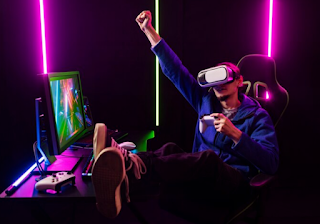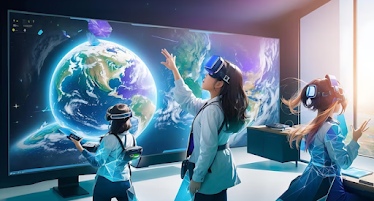Uncovering the Groundbreaking Job of simulated intelligence and AI in Virtual Game Turn of events
In the steadily developing scene of the gaming business, virtual game improvement has arisen as a force to be reckoned with, enamoring players with vivid encounters that obscure the lines among the real world and fiction. The combination of Man-made brainpower (computer based intelligence) and AI (ML) has arisen as a distinct advantage in virtual game turn of events, reclassifying the limits of imagination, submersion, and ongoing interaction encounters. By utilizing these state of the art advances, the virtual game improvement organization can rethink player encounters, from similar conditions and astute NPCs to versatile ongoing interaction mechanics. In this article, we dig into the exciting area where advancement meets creative mind, uncovering the significant effect of man-made intelligence and ML in the domain of virtual game turn of events.
What
is Virtual Game Turn of events?
Virtual game improvement
incorporates the complex course of planning, making, and refining vivid
computerized encounters inside a reproduced climate. A virtual game improvement
organization works in creating these virtual universes, where state of the art
innovations, imaginative ability, and specialized mastery join to bring
charming stories, complex ongoing interaction mechanics, and outwardly dazzling
scenes to life. Through a careful mix of creativity and programming, these
organizations influence progressed devices, including simulated intelligence
and AI, to shape intuitive universes that enamor and draw in players, offering
a consistent combination of creative mind and innovation in the domain of
gaming.
Job
of artificial intelligence and ML in Virtual Game Turn of events
A virtual game development
company offers a scope of state of the art virtual game improvement
administrations, utilizing cutting edge innovations like computerized reasoning
(simulated intelligence) and AI. They assume a vital part in different parts of
virtual game turn of events, improving interactivity, illustrations, client
experience, and by and large game plan. The virtual game improvement
organization incorporates a wide range of skill, including:
Procedural
Substance Age (PCG):
The virtual game advancement
organization uses computer based intelligence and ML strategies to create game
substance, like landscape, levels, surfaces, and resources, procedurally. This
guarantees dynamic and various ongoing interaction encounters, keeping players
connected with and submerged in steadily advancing virtual universes.
Brain
Organizations:
Profound learning brain networks
are utilized by a virtual game improvement organization for undertakings like
person liveliness, looks, and lip-matching up, bringing about more reasonable
and exact in-game characters that answer really to player activities.
Constant
Beam Following:
Spearheading the fate of gaming
visuals, a virtual game improvement organization utilizes man-made intelligence
driven strategies, for example, profound learning-based denoising to facilitate
ongoing beam following, subsequently propelling the domains of lighting,
shadows, and reflections, at last enhancing visual authenticity and taking the
generally speaking graphical devotion to phenomenal levels.
Normal
Language Handling (NLP):
A virtual game improvement organization
use NLP calculations to make dynamic and logically important exchanges, in this
way enhancing cooperations with non-player characters (NPCs) and hoisting the
specialty of narrating, bringing about a significantly vivid story experience
for players.
Conduct
Trees:
At the front of advancement, a virtual game
improvement organization saddles the force of man-made intelligence driven
conduct trees to coordinate NPC activities and direction, bringing about the
making of extraordinarily exact and dynamic in-game elements that flawlessly
adjust to the consistently changing elements of players.
Support
Learning (RL):
Virtual game advancement administrations use
Support Learning (RL) to prepare NPCs, empowering versatile way of behaving and
making imposing adversaries that persistently challenge players, encouraging
connecting with interactivity.
Procedural
Liveliness:
Inside the domain of virtual game
advancement administrations, ML calculations analyze true movement information
to make similar activitys for characters, animals, and items, mixing smoothness
and realness into in-game activities, in this way improving the generally vivid
experience.
Dynamic
Trouble Change (DDA):
Consolidating state of the art
innovation, virtual game improvement administrations utilize computer based
intelligence driven DDA calculations to assess player expertise and
progressively tweak game trouble, conveying an enrapturing experience that
modifies difficulties to every player's one of a kind capacities.
Prescient
Examination:
Saddling the abilities of present
day innovation, virtual game advancement administrations utilize ML models to
break down player conduct and inclinations, making customized encounters,
designated promoting, and content suggestions that extend commitment in the
gaming local area.
Style
Move:
In the domain of virtual game
improvement administrations, ML procedures, for example, brain style move,
offer the capacity to implant workmanship styles into in-game visuals. This
awards the game world a particular and outwardly enrapturing appearance,
separating it from customary plans and improving the general stylish allure.
Hostile
to Swindle Frameworks:
man-made intelligence based enemy
of cheat frameworks use design acknowledgment and peculiarity recognition to
recognize and forestall deceiving ways of behaving, keeping up with fair
interactivity and guaranteeing a level battleground for all members.
Pathfinding
and Route:
ML-fueled pathfinding
calculations assist NPCs with exploring complex conditions and keep away from
deterrents, improving their spatial mindfulness and making more insightful and
proficient virtual elements.
Game
Testing Mechanization:
ML-driven testing structures can
reproduce human player conduct and recognize bugs, errors, and lopsided characteristics
in the game, smoothing out the quality confirmation process and guaranteeing a
cleaned finished result.
Truly
Based Delivering (PBR):
Artificial intelligence helped
PBR procedures upgrade material properties, bringing about additional reasonable
surfaces and lighting cooperation’s that add to an elevated feeling of visual
submersion.
Character
Customization:
ML models investigate player
inclinations and produce altered character appearances, attire, and extras,
permitting players to make special symbols that reverberate with their singular
styles and inclinations.
The reconciliation of man-made
intelligence and ML is changing how games are made, experienced, and esteemed.
From creating exact NPCs to producing far reaching game universes, from improving
designs to anticipating player conduct, artificial intelligence and ML are
driving advancement and increasing present expectations for intuitive
diversion.
Shamla
Tech's Ability in Changing Virtual Game Improvement through computer based
intelligence and ML Coordination
Shamla Tech, a main virtual game development
services, succeeds in flawlessly coordinating man-made intelligence and ML
advances into virtual game improvement administrations. Utilizing state of the
art man-made intelligence calculations and AI models, we improve interactivity
mechanics, make dynamic NPCs, advance procedural substance age, and convey
practical virtual conditions. By saddling the influence of simulated
intelligence and ML, we advance client encounters, engage versatile narrating,
and upgrade asset designation for unmatched gaming inundation. Our aptitude
guarantees that simulated intelligence and ML are flawlessly woven into the
texture of virtual game turn of events, pushing the limits of advancement and
commitment to the gaming business.


Comments
Post a Comment